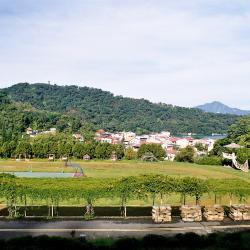Ita Thao is located in Riyue Village, Yuchi Township, Nantou County. During the Japanese occupation period, it was called Buji or Huafanshe. After Taiwan's recovery, it was renamed Dehuashe. After the Thao became Taiwan's tenth officially recognized indigenous group in 2001, the word "Dehua", (short for "Dehuafan"), which implied full of authority and colonial superiority, was unfit and was renamed Ita Thao. However, the local Dehua Police Station and Dehua Elementary School still use the old names. After years of hard work by the Thao people, the Dehua Police Station was renamed Ita Thao Police Station on October 3, 2018, and the Dehua Elementary School was also renamed Ita Thao Elementary School on August 1, 2019.
Shuishalian
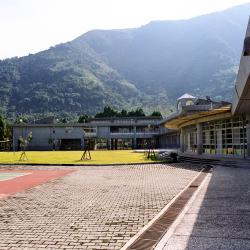
Dongguang Elementary School was founded in April of the 11th year of Taisho (1922), and it was named Yuchi Public School. It was a branch of another school and only has one school grade. In April 1941, it became an independent Dongguang Elementary School. In September 1959, the school implemented class separation. In 1968, the nine-year state education was implemented, and its name was changed to Dongguang National Elementary School. Due to changes in the social structure, large population exodus, and the impact of birth control policies, the number of students gradually decreased. During the 921-earthquake, Dongguang Elementary School was severely damaged. With the assistance of the Tzu Chi Cultural and Educational Foundation, it adopted the reconstruction project. The inauguration ceremony of the new school building was completed on November 24, 2001.
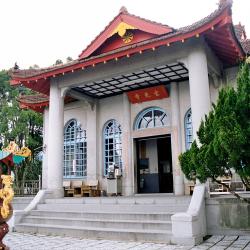
Xuanguang Temple is only more than ten meters away from Sun Moon Lake. There is a pier under the temple. Tourists can take a boat to the pier and then walk up the steps to visit the temple. During the Second World War, the Japanese obtained the spiritual bones of Master Xuanzang in Nanjing, brought them back to Japan, and enshrined them in the Ci'en Temple in Saitama County, Japan. It was brought to Xuanguan Temple next to Sun Moon Lake in 1956 after multiple negotiations with Japan. When the Xuanzang Temple was built in 1965, the spiritual bones of Master Xuanzang were transferred to Xuanzang Temple. Although the spiritual bones have been transferred to Xuanzang Temple, but due to the convenient waterway transportation, Xuanguang Temple has become a must-visit attraction for tourists visiting Sun Moon Lake. The golden body of Master Xuanzang is enshrined in the temple, with the plaque of "National Master" hanging above it.
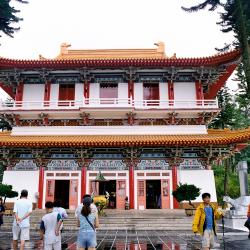
Xuanzang Temple was founded in 1965 at No. 261, Zhongzheng Road, Riyue Village, Yuchi Township, Nantou County. Xuanzang Temple is built along the mountain with two-level foundations. The lower level is close to the road near the lake. There is a relief sculpture of the "Master Xuanzang's Procession in the Western Regions", and three steles that inscribe "Friendship between Japan and Chinese Buddhism", "Biography of Master Xuanzang of the Tang Dynasty", "Monument of Goodwill and Exchanges between Japan and Chinese Buddhism”. During the Second World War, the Japanese obtained the spiritual bone of Master Xuanzang in Nanjing, and then brought it back to Japan and enshrined it in the Ci'en Temple in Saitama County, Japan. It was brought to Xuanguan Temple in 1956 after multiple negotiations with Japan. When the Xuanzang Temple was built in 1965, the relics of Master Xuanzang were enshrined in the temple for people to look up to.
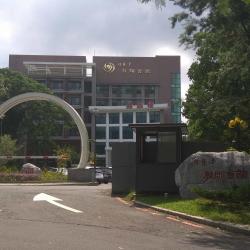
The Sun Moon Lake Teacher’s Hostel on the Hanbi Peninsula used to be the Sun Moon Lake Forest School during the Japanese occupation. After the completion of the Sun Moon Lake hydropower project, Taichung State chose to set up the Sun Moon Lake Forest School on the shore of Sun Moon Lake. Construction began on September 8, 1934, and was completed on January 10, 1935. The campus facilities include four dormitories, lecture halls, canteens, bathrooms, and kitchens. The total area is 873 square meters and can accommodate 140 people, making it the largest among the forest schools in Taiwan. During the period of the imperialization movement, the Sun Moon Lake Forest School often held national spiritual and cultural seminars. After World War II, the Yuchi National School was established in June 1949 at the original site of the Sun Moon Lake Forest School, and in 1952 it became the Mingtan National School. In 1960, Mingtan National School moved to the current site of Mingtan Elementary School, and the original site was later converted into the Sun Moon Lake Teacher’s Hostel.
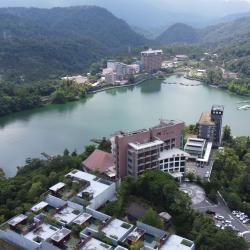
Before Sun Moon Lake was constructed with hydroelectric fortifications, Beidan was originally 600 meters away from the edge of the lake. After the water level of Sun Moon Lake rose, it became close to the lakeshore. Beidan is the largest settlement in Shuishe Village. It is distributed along the Taiwan Provincial Highway 21. There is a small pier in Beidan, which is one of the two piers in Sun Moon Lake that can carry out water activities. The other is the Panshi pier next to Ita Thao pier. The Longfeng Temple is dedicated to the God of the North Pole, the Virgin of Heaven, and the Patriarch of Shame. It is the most spectacular temple on the west side of Sun Moon Lake. Different from other temples with painted door gods, it also uses three-dimensional reliefs in the shape of dragons and phoenixes, which is quite distinctive. The Yuelao Temple on the left side of Longfeng Temple was originally located on Lalu Island. After it was destroyed by the earthquake, it was moved to the side of Longfeng Temple and is a popular attraction.
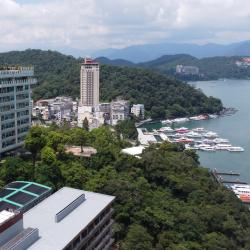
Looking at Shuishe Harbor from Hanbi Peninsula, Shuishe Harbor is one of the four harbors in Sun Moon Lake, and it is also the starting point for tourists to take a boat tour of the lake. Shuishe is located on the north side of Sun Moon Lake. It is the transportation center of Sun Moon Lake, as well as the hub for hotels and shops. Shuishe was originally an old Thao community, located on the northwest bank of Sun Moon Lake. Because the community was built in the middle of the lake or on the waterside of the lake, the Han people called it Shuishe or Shuilishe. In the early days of the Japanese occupation, the Shuishe of the indigenous community had become a Han village, and most of the people migrated to the Nan’anshiyinshe, calling themselves Tarimukan-she. In the 9th year of the Showa Period (1934), the Japanese built the Sun Moon Lake hydropower project, and the Thao people were forced to move out of their original home and moved to Tan’nan Village, Xinyi Township. The old village that was originally by the lakeside has been submerged in the lake.
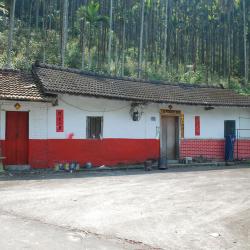
This is a residential house in Chonggui. Chonggui is located in the Chonggui Basin in the southwest of Wudeng Village, Yuchi Township, Nantou County. At the beginning of the Han people's reclamation, in order to prevent the indigenous peoples from invading, the residents set up a gun platform, hence the name Chonggui (the gun cabinet). At the end of the Qing Dynasty, it was called "Chongguizhuang", and during the Japanese occupation period, it was first renamed "Chongguizhuang" or "Chonggui Dazi". After the war, Chonggui Dazhi and the lower part of Toushe Dazhi merged into Wudeng Village, which was under the jurisdiction of Yuchi Township, Xingao District, Taichung County. In October 1950, Nantou County was established, and Wudeng Village was changed to be under the jurisdiction of Yuchi Township, Nantou County. Wudeng Village includes Toushe and the No. 2 Basin of Chonggui. Most of the residents make a living from farming. At present, they grow loofahs, betel nuts, vegetables, and other crops. Most of the irrigation water comes from streams or springs.
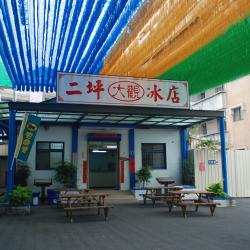
Daguan Ice Cream Shop is part of the cafeteria of Taiwan Power Company Daguan Power Plant in Shuili Township, Nantou County. When taking the Shuishalian Historic Trail from the Shuili to the Chonggui, you will pass the Taipower Erping Ice Cream Shop and Daguan Ice Cream Shop. The two shops are not far apart, and also sell high-quality and affordable ice products, which are very popular among tourists. The Daguan Power Plant was built during the Japanese occupation period. It was called "Menpaitan Power Generator Station" then and was later renamed "Sun Moon Lake No. 1 Power Station". In 1945, after the end of World War II, the Nationalist government came to Taiwan, and Sun Yunying, the then director of Taipower Electric Power Division, with the assistance of Japanese technicians, restored the power supply of Sun Moon Lake No. 1 Power Station on October 30, 1946. In October 1946, the Sun Moon Lake No. 1 Power Plant was named "Daguan Power Plant" by Chiang Kai-shek.
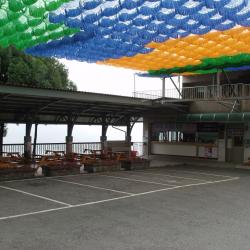
Erping Ice Cream Shop is part of the cafeteria of Taiwan Power Company Mingtan Power Plant in Shuili Township, Nantou County. When taking the Shuishalian Historic Trail from the Shuili to the Chonggui, you will pass the Taipower Erping Ice Cream Shop. The ice products sold there are of high quality, at affordable prices, and are very popular among tourists. From there you can also overlook the urban area of Shuili, which is a well-known scenic spot in Shuili. In 1987, in view of the abundant natural water resources of Sun Moon Lake, Taiwan Power Company used Sun Moon Lake as the upper dam, and built another dam in the lower pool about 4 kilometers downstream of Daguan No. 2. The drop of about 380 meters between the two pools is used for pumped hydropower generation. The completed power plant is called "Mingtan Power Plant" and was completed in 1995. The capacity at the time of completion dominates Asia, the fourth largest and one of the few pumped storage power plants in the world.
